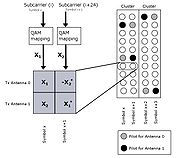
Space–time code
Encyclopedia

Transmission (telecommunications)
Transmission, in telecommunications, is the process of sending, propagating and receiving an analogue or digital information signal over a physical point-to-point or point-to-multipoint transmission medium, either wired, optical fiber or wireless...
in wireless communication systems
Wireless
Wireless telecommunications is the transfer of information between two or more points that are not physically connected. Distances can be short, such as a few meters for television remote control, or as far as thousands or even millions of kilometers for deep-space radio communications...
using multiple transmit antennas
Antenna (radio)
An antenna is an electrical device which converts electric currents into radio waves, and vice versa. It is usually used with a radio transmitter or radio receiver...
. STCs rely on transmitting multiple, redundant
Redundancy (information theory)
Redundancy in information theory is the number of bits used to transmit a message minus the number of bits of actual information in the message. Informally, it is the amount of wasted "space" used to transmit certain data...
copies of a data stream to the receiver
Receiver (radio)
A radio receiver converts signals from a radio antenna to a usable form. It uses electronic filters to separate a wanted radio frequency signal from all other signals, the electronic amplifier increases the level suitable for further processing, and finally recovers the desired information through...
in the hope that at least some of them may survive the physical path
Transmission medium
A transmission medium is a material substance that can propagate energy waves...
between transmission and reception in a good enough state to allow reliable decoding.
Space time codes may be split into two main types:
- Space–time trellis codeSpace–time trellis codeSpace–time trellis codes are a type of space–time code used in multiple-antenna wireless communications. This scheme transmits multiple, redundant copies of a trellis code distributed over time and a number of antennas . These multiple, 'diverse' copies of the data are used by the receiver to...
s (STTCs) distribute a trellis codeConvolutional codeIn telecommunication, a convolutional code is a type of error-correcting code in which* each m-bit information symbol to be encoded is transformed into an n-bit symbol, where m/n is the code rate and...
over multiple antennas and multiple time-slots and provide both coding gain and diversity gain. - Space–time block codeSpace–time block codeSpace–time block coding is a technique used in wireless communications to transmit multiple copies of a data stream across a number of antennas and to exploit the various received versions of the data to improve the reliability of data-transfer...
s (STBCs) act on a block of data at once (similarly to block codeBlock codeIn coding theory, block codes refers to the large and important family of error-correcting codes that encode data in blocks.There is a vast number of examples for block codes, many of which have a wide range of practical applications...
s) and provide only diversity gain, but are much less complex in implementation terms than STTCs.
STC may be further subdivided according to whether the receiver knows the channel
Channel (communications)
In telecommunications and computer networking, a communication channel, or channel, refers either to a physical transmission medium such as a wire, or to a logical connection over a multiplexed medium such as a radio channel...
impairments. In coherent STC, the receiver knows the channel impairments through training or some other form of estimation. These codes have been studied more widely because they are less complex than their non-coherent counterparts. In noncoherent STC the receiver does not know the channel impairments but knows the statistics of the channel. In differential space–time code
Differential space–time code
Differential space–time codes are ways of transmitting data in wireless communications. They are forms of space–time code that do not need to know the channel impairments at the receiver in order to be able to decode the signal. They are usually based on space–time block codes, and transmit...
s neither the channel nor the statistics of the channel are available.
See also
- Diversity schemeDiversity schemeIn telecommunications, a diversity scheme refers to a method for improving the reliability of a message signal by using two or more communication channels with different characteristics. Diversity plays an important role in combatting fading and co-channel interference and avoiding error bursts...
— the concept from which STC arose. - MIMOMIMOIn radio, multiple-input and multiple-output, or MIMO , is the use of multiple antennas at both the transmitter and receiver to improve communication performance. It is one of several forms of smart antenna technology...
— the term for wireless communication systems employing multiple antennas at both a transmitter and a receiver.

